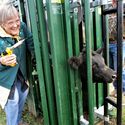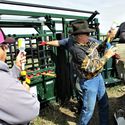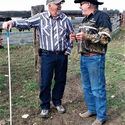South of the Boarder: Flatlanders help 'work cows' in the Hills
October 16, 2019
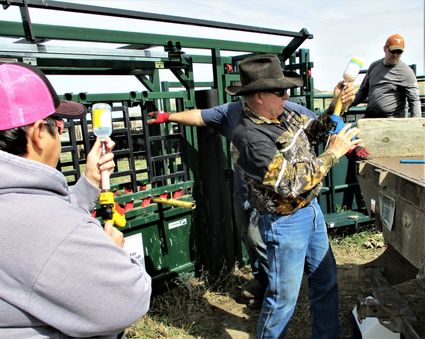
Bob Thompson, center of photo in hat, and Diana Thompson, left of photo, reload syringes while working calves at the 3U Cattle Company south of Whitlash in the Sweet Grass Hills. Friends from Great Falls, Austin Schultz, right of photo, and "Tiny" Wild, behind Bob, were also helping with the preconditioning work. Jeff Thompson was manning the chute to the head gate.
Columnist's note: In 2000, when my wife graduated from seminary and started a new career as a Presbyterian minister, we made an agreement: she had followed me and my career locations for about 30 years, now I would follow her and her career. While she pastored churches the arrangement has allowed me to try some interesting jobs in some far flung places-working on a grain farm in North Dakota, at a sugar beet plant in Minnesota, being a "toilet ranger" for the Forest Service in the Kootenai Forest and serving, alongside my wife, at a church camp on Flathead Lake.
With our move to the Sweet Grass Hills where my wife is Pastor-in-residence we've been looking forward to experiencing a bit of what ranch life is about. We recently got a chance to help "work cows in the Sweet Grass Hills" as guests of Bob and Diana Thompson who own and operate, along with their son, Jeff, 3U Cattle Company just south of Whitlash. They invited us to "have lunch with us while we work the calves." After lunch and some time helping work the calves, we understood a bit more about one of many steps involved in getting animals to market.
A primer about preconditioning calves for the market
In Chinook we watched loaded cattle trailers hauling calves in the fall. We visited brandings and saw that aspect of ranching. I travelled a couple times with local vets as they tested and checked cattle. I even spent a day with a cattle buyer one fall. But neither my wife nor I had heard of preconditioning or knew why it's done.
Basically, preconditioning is "activities by ranchers that prepare calves to enter the feedlot, reducing stress and disease susceptibility." Bob Thompson explained that he, family and friends, were giving shots to calves going to a feedlot in Kansas at the end of October. He added, "While the preconditioning shots are a cost to our operation the buyers want to know they are getting healthy animals that won't cause problems or losses at the feedlot."

I asked Thompson if there was a financial benefit from spending resources to precondition the calves. He explained, "While the rancher may not get a bonus there won't be a discount. You could say the cost is neutral, but in my opinion preconditioning is necessary." He added, "consistently providing reliable and quality animals has paid off for us. I believe we get better prices because our buyers know what we will provide."
I also learned there is "no one-size-fits-all" preconditioning program. "There is a vast difference in preconditioning," a manager of a commercial health tracking company wrote, "depending on where you are in the country." Thompson, of 3U Cattle Company, agreed, "My shot protocols are based on advice from local veterinarians and my own experience. What works in the Sweet Grass Hills and on my place may not work for others."
For the upcoming shipment of calves Thompson was giving two shots: one 'live shot' contained an active virus to treat five potential respiratory problems; the second for 'blackleg.' Blackleg is a problem that's been around since medieval times and loosely describes several diseases caused by spore-forming organisms in the soil or environment. One symptom can be blackened muscles on a sickened animal, hence the name blackleg. This group of diseases is found worldwide, spreads rapidly and is usually fatal.
We flatlanders use our skills to work the cows
While Diana Thompson was at the house putting lunch together, Bob was operating the head gate and two syringes. My wife, who was a registered nurse for many years, asked Bob if she could help give shots. He showed her how to open a gate at the head chute to access the calves and the proper way to 'pinch' the skin to assure a correct shot. In a couple of minutes she was giving the 'live shot.'
Since I'm notoriously mechanically-impaired, Bob made sure I didn't do anything with equipment where I could hurt myself or break something. He did give me one of those fiberglass sorting sticks which I felt made me sort of look like a cowboy and had no sharp points. I opened and closed the little gate at the head gate so my wife, Sherry, could reach in and give shots. I have to admit, I got pretty good at opening that little gate.
Finally, Jeff Thompson, who was working at the back of the chute and moving the calves to the head gate, called me over to help him 'sort cows.' We would go to a pen in the corral, separate several calves from the cows and move the calves toward the chute that fed to the head gate.
One thing I learned while sorting calves was that "herd instinct" is sort of a vague notion as far as calves are concerned. One or two insisted they were going to head the opposite direction from the rest of the herd that was moving the right way. It was good exercise for me as I had to shuffle back and forth to turn back the rogue calves going their own way. I waved the sorting stick at them but was careful not to stick or whack myself.
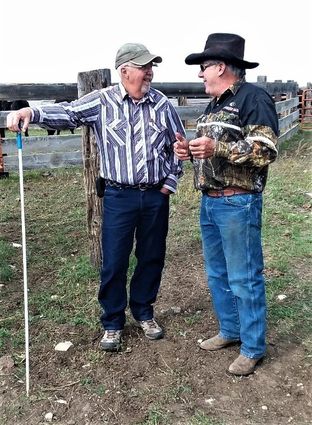
"South of the Border" columnist Steve Edwards, left, chats with rancher Bob Thompson of the 3U Cattle Company near Whitlash. Edwards was helping sort calves that were being preconditioned. Bob laughingly congratulated the writer on how quickly he adapted to "leaning on the sorting stick in a very professional manner."
It was a great first experience for us, all sunny and nice with a great view of Gold Butte just west of the big corral. I'm guessing it's not always all sunshine and dry feet. Maybe next time working cows we'll get the full deal-bad weather and all.


